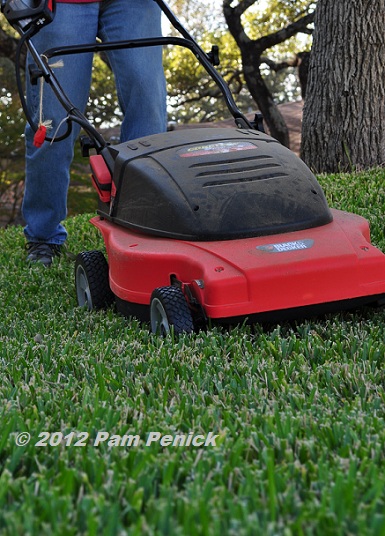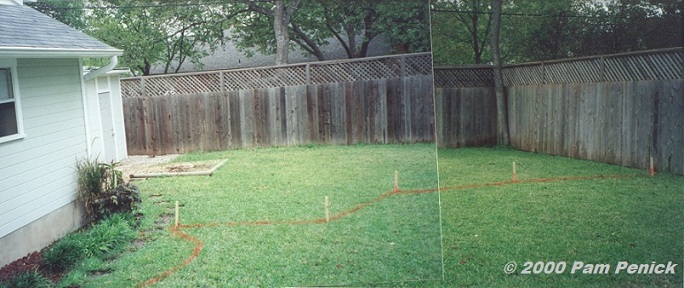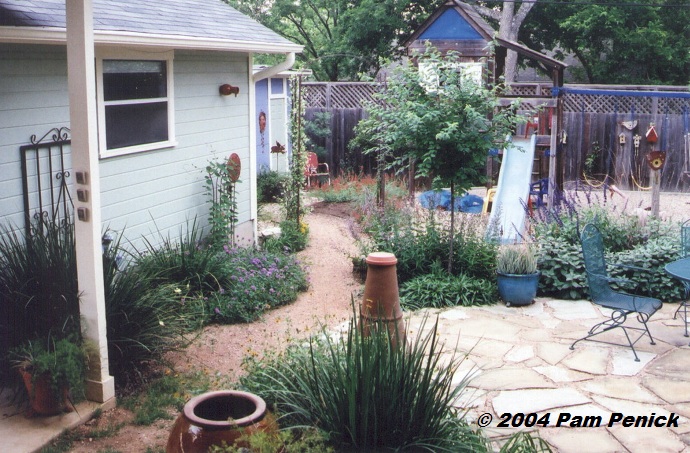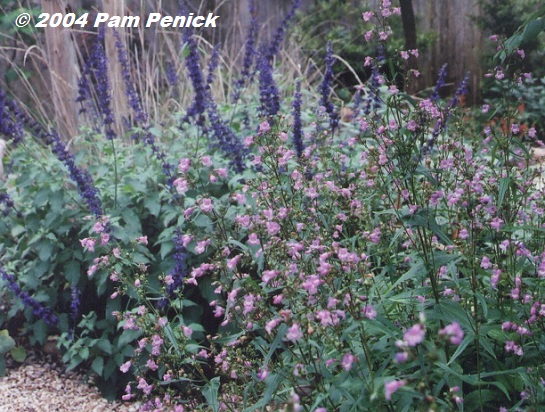My less-lawn obsession goes WAY back, I discover

As Texas continues to suffer through drought, along with a significant portion of the country, the topic is just as relevant today as 7 years ago. I’m republishing it here in hopes that it may inspire a few people to convert their lawns into more sustainable and enjoyable landscapes.
Less Lawn, Less Water, More Beauty
When T.S. Eliot wrote that April is the cruelest month, he obviously never knew about August or September in our heat-stressed city. Summer in Austin means scorching heat, drought, and sky-high watering bills to keep those water-loving lawns lush and green. It’s time to retreat to the air-conditioned house and plan for fall gardening.
If a thirsty St. Augustine lawn dominates your yard, perhaps you’re thinking of ways to reduce your water bill next summer and give your landscape a more distinctive and Texas look. Too often we tend to live with the builder’s original mix of lawn, solitary shade tree, and overgrown line of evergreens along the front of the house. If you’re dreaming of something different, go for it! Carve out a section of your yard that receives blistering sun, and plant a sun-loving xeriscape garden like the one installed by our neighborhood’s beautification committee along Hancock Dr. on the east side of the bridge. Or take out the struggling lawn under your live oak, and grow a shady oasis of native woodland plants that will attract songbirds and hummingbirds. Using plants native to central Texas or adapted to our unique conditions will decrease your water bill, require less work than dainty species from other parts of the country, and connect your garden to the beauty of our region.
When my husband and I moved into the neighborhood five years ago, we inherited a yard devoid of shade, interest, or wildlife. I knew I wanted something pretty to look at, plants that could take the heat and drought, and a garden that would be attractive to birds, butterflies, and most important, my family and me.
The back yard, like the front, began as an expanse of water-guzzling, boring St. Augustine lawn. As you can see in this “before” photo, taken in the fall of 2000, your eye travels straight across the lawn to the back fence. Great for a game of soccer, maybe, but not what I wanted to look at every day. The markings indicate where we planned to remove grass in order to install a path and a playscape for the kids.
Three years later, in April 2004, this is how our back yard looked. No longer does the lawn dominate—in fact, the lawn is gone. In its place are a stone patio, a play area for the kids, a curvy path, and lots of native and adapted plants. While I sometimes miss having a grassy area for the kids to play on, I don’t miss the mowing, fertilizing, edging, or extra watering that a St. Augustine lawn requires. Plus, the variety of plants that grow in its place attract birds, butterflies, toads, and bees, and offers natural beauty.
I didn’t tackle these changes all at once. My husband and I installed the playscape first, removing half our lawn in the process. Little by little over the next couple of years, I dug out more garden beds until finally I just ran out of room. This kind of gardening is easier on the back and on the budget than doing it all at once. And not everyone wants to eliminate the lawn completely. Even reducing the size of your lawn by 25 percent can significantly alter the look and watering needs of your yard.
‘Indigo Spires’ salvia and Gulf Coast penstemon (Penstemon tenuis)
Of course, even a native garden needs to be watered, especially the first year. However, if you plant in the fall (October through December is best) and water regularly, your new plants will grow deep roots all fall and winter. By the following summer, they will be better prepared to survive the heat than specimens planted in the spring. Watering deeply (about 2 inches) every 10 to 14 days during the hot months will ensure your new garden’s health and encourage deep root growth.
Growing native plants is rewarding, and it connects you to the land you live on. Next summer, while your lawn crisps and your sprinkler runs, sketch some ideas on paper. Come fall—and it’s bound to come eventually—start digging and planting. By spring you’ll be enjoying your new native garden and eyeing the rest of your lawn with sketchpad in hand, wondering how much lawn you really need.
Originally published in The HPWBANA News, September 2005
All material © 2006-2012 by Pam Penick for Digging. Unauthorized reproduction prohibited.





Especially like the last para on the strategy of watering. So few people get that until they are told it!
Best
R
It’s a common mistake here in Austin, Robert, to think that drought-tolerant plants can live without watering right after planting. —Pam
Very cool – I can’t wait to read this again in more detail, later. Less-lawn obsession…ha ha…as a guy, the earliest piece of machinery I was given to work was a lawn mower, so I liked lawns, even on 2/3 acre of St Augustine, etc lawn in Alabama…even in summer, it was fun until I learned to drive. It took until after college (’88) before I realized all-lawn was boring, wasteful, etc if unnecessary. I was against xeriscape as long, until I saw good examples. Funny how we change, Pam “Less-Lawn” P!
Many men, it seems, have early memories and a certain fondness about mowing the lawn. My husband is not one of them and has never complained about my desire to substitute a garden bed for lawn. My son is the mower at our house now, and he also loves that I’m whittling away the remaining lawn. —Pam
I heartily agree with your Less-Lawn aesthetic.
Unfortunately, my development is very pro-lawn. Not just that, pro-weed-free-lawn (which means lots of chemical herbicides).
Sigh.
We just hired a landscaper to install 9 trees and a bed of perennials and grasses in our front lawn. I love the way it looks and it cuts down on the lawn a little bit, but we’ve got a biggish property for suburbia (~.8 acres) and there’s still quite a bit of lawn front and back.
That’s probably for the best. Unfortunately, I think our HOA would throw a fit if we tried to nix the whole lawn.
Maybe someday their ideas will change and more people here in Tennessee will embrace the concept of less lawn, less mowing, less watering and more beautiful, varied landscapes.
I hear you, Aaron. There are certain neighborhoods in Austin that have very strict HOA rules about landscaping, and more of them used to be quite strict about having mostly lawn too. But I think most HOAs are only a serious drought or two (and mandatory watering restrictions imposed by the city) from loosening their landscaping codes. Until then, moving slowly, as you’re doing, is a smart strategy. I have more tips in my upcoming book for dealing with lawn-loving HOAs. —Pam
Nice article. I developed my garden in a similar way, digging up a section of lawn every year.
Slowly but surely wins the race, right, Jason? —Pam
I’m glad I found your blog (thru Tropical Texan’s blogroll)!
The Algarve is also a dry place most of the year. I put in a lawn when I moved in 7 years ago and I’ve been reducing it slowly since the beginning. Now I’m trying to get the courage to remove it altogether so I love finding great ideas.
Welcome, Mara! I look forward to visiting your blog as well. —Pam
I almost always think that those who continue to maintain a lawn just do so because it’s all they know and/or see in their area…or they just don’t care about their yard to begin with. Then again…there are those who really LOVE their lawns (which amazes me). I’ve never liked them (lawns, that is)…then again, growing up, I had to mow my parents’ huge lawn (we lived on an acreage in the country)…so that may have jaded me a bit 😉
I can see why you lost any love of lawn, Scott, after regularly mowing an acreage in your youth. Ironic though that you love ornamental grasses so much! So do I, actually, and they make a great lawn alternative. —Pam
I pulled the grass from my yard and replanted about 4 years ago so that it is now a habitat for birds and butterfly’s, and requires no watering. I loved the process, the transformation that takes time. I really enjoyed what you did. The detail and the texture you incorporated is very appealing to the eye. Thank you for posting.
Congrats on your lawn-to-garden transformation, Charlie. I bet you enjoy it a lot more than a lawn. —Pam
Another great article, Pam. What an incredible before and after shot too. I bet, especially back in 2000, people thought you taking out all that grass was a little strange – especially when it looked healthy. You showed them! 😉
The first thing we did was take out a mature but dying Arizona ash, Heather, and when the former owners saw what we’d done, they really did think we were crazy. Since then, of course, a cedar elm and Mexican plum that I planted for shade have grown and now are big and healthy. I don’t know why people hang onto half-dead trees, but that’s another blog post. —Pam
Excellent. Less lawn is good for sure. Here, I have prairie grass that isn’t watered. It’s brown by mid-summer. I only have the small lawnette in front. It is my green oasis, but if this drought continues, it may have to go too.~~Dee
I hope you get to keep your lawnette, Dee, since you enjoy your small patch of green. I think a small lawn that feeds the soul definitely has a place in the world, assuming there’s enough water to keep it. Here’s to rain next year in the Plains states! —Pam
How fascinating. You were ahead of your time. I can’t wait to read the whole book. This was certainly the year for removing lawn in the landscaping business.
It really was! Drought quickly changes people’s minds about lawn, doesn’t it? —Pam
Pam, I came to your blog in 2007, I think, and had not seen what the back yard looked like originally. I knew you had done a wonderful job getting rid of the lawn, but my gosh – I had no idea. I’ve been following the transformation of the new yard (not so new now), which is even more amazing. I recently found some early pictures of my place after I moved here in 2007. That was good. I’ve been busy! Something each year makes it more doable.
Congrats on your own garden transformation, Barbara! It’s so satisfying to look back at “before” pictures, isn’t it? —Pam
What a dramatic before and after. An oasis create with love. Looking forward to your book! Your beautiful penstemon ….. looking forward to spring.
Have you noticed one subdivision will have many energy-wise and water-wise designs and an adjacent subdivision will be exclusively lawn designs?
Yes, I’ve seen that too. Isn’t it nice when waterwise landscaping in one neighborhood inspires another to do the same? —Pam